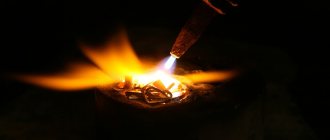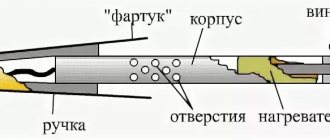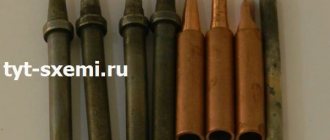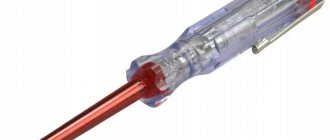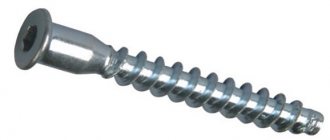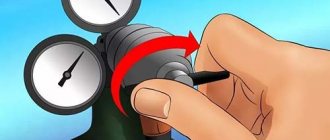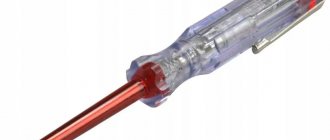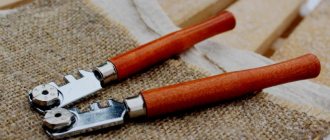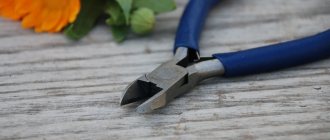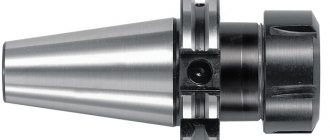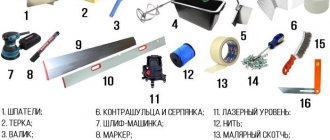Electronic microcircuits are installed not only in televisions and music centers. They are equipped with door locks and refrigerators, various drives and lighting devices. They perform the functions of microprocessors, memory, power supplies, and other devices. Current trends indicate a gradual expansion of the scope of their application. Therefore, a soldering iron for microcircuits is useful for equipping a modern personal workshop. With its help, you can quickly make repairs or upgrades, without resorting to the services of expensive specialists and other unnecessary costs.
In a large assortment of offers from specialized stores, it is not difficult to choose tools for successfully solving specific problems
Types of soldering irons
Soldering irons come with a ceramic or spiral heater. The difference is that ceramics heats up much faster, but requires more careful use: a strong blow will cause such a soldering iron to fail.
Spiral is not afraid of impacts, and it will last for many years. When choosing a soldering iron, you need to pay attention to its power. It is necessary to take into account that if you are soldering microcircuits, then it is advisable to choose a soldering iron with a nominal value of 10-20. Soldering irons rated above 60 W are designed for soldering thick wires.
A soldering iron with low power simply will not be able to melt the solder, since the power will be dissipated over a large soldering area. For soldering large metal parts, there are soldering irons from 100 watts and above. The most optimal soldering iron for a beginner is 25-40 W. This soldering iron is considered universal, and it can perform most tasks. Typically, radio amateurs have several soldering irons in their arsenal to cover a wide range of jobs.
Table of models of soldering irons for microcircuits.
In general sale, normal and reliable soldering irons for microcircuits are almost a rarity. If a person is engaged in repairing equipment professionally, he can purchase a suitable working tool. But he would rather choose a soldering station with all the necessary devices for soldering and the ability to set operating modes.
This is interesting! All about semiconductor diodes.
Soldering iron tip
Pay attention to the soldering iron tip. It comes in copper or nickel plated. A copper tip is better suited for soldering, as copper has high thermal conductivity. It can be cleaned with sandpaper or a file, but such a tip burns very quickly. Nickel is used in conjunction with a soldering iron, which has a temperature control, but its disadvantage is that the tip of this type cannot be cleaned with either a file or sandpaper.
After this treatment, the solder will no longer stick to the soldering iron. Quite a lot of people do not know about this feature of nickel tips, and after cleaning such a tip, soldering work turns into hell. The tip is a replaceable element with various types of fastening. Some soldering irons have a cap that is screwed on to secure the tip, while others have the tip secured with a screw.
The sting has a different shape. The soldering iron is sold with a universal tip already installed. They can do most jobs. There are stings as thin as a needle. They are intended for jewelry work involving soldering SMD components and are not capable of performing other tasks. Wide tips are designed for quick heating of the entire part and convenient installation/disassembly of the component.
Soldering iron tip soldering iron for microcircuits
Temperature adjustment
There are soldering irons with manual temperature control on the handle itself. This is an excellent thing for a radio amateur, since without this function there is always a chance of accidentally burning or overheating one or another component. If you overheat a radio component, it will lose its original properties and will work unstably, or even fail altogether.
The tip of a soldering iron tends to burn out during prolonged use. If your soldering iron does not have temperature control, be prepared to buy a new tip often. However, the disadvantages of such soldering irons include the inconvenient location of the handle adjustment and the not very reliable design.
Standalone devices
In addition to the types listed above, mention should be made of autonomous type devices, that is, those that can operate without being connected to an electrical outlet, these include:
- a gas soldering iron in which the tip is heated by the flame generated by the combustion of gas. In essence, this is an ordinary gas burner, which uses nozzles for soldering;
Gas type soldering device
- battery-powered soldering irons;
Mini soldering iron with independent power supply
Soldering Station
In addition to the soldering iron, you can purchase a hot air soldering station. This is a powerful tool in the hands of a radio amateur. This tool is equipped with temperature settings accurate to one degree. The soldering station has a convenient stand. Using such a device, you can solder not only small radio components, but also desolder entire microcircuits from boards using hot air.
It might be interesting➡ How to connect an ammeter to an AC or DC circuit
Soldering stations can significantly speed up your work. But to solder with such a station, experience is required. For beginners, there is no need for a soldering station at first. A simple soldering iron is enough to learn soldering skills. But once you get comfortable and confidently hold a soldering iron in your hand, you can think about more expensive equipment.
Soldering Station
What is smd
Sub Micro Devices, subminiature devices. You can clearly see the SMD by opening your mobile phone, smartphone, tablet or computer. Using SMD technology, tiny (perhaps smaller than the cut of a match) components without wire leads are mounted by soldering onto contact pads, called polygons in SMD terminology. The polygon may have a thermal barrier that prevents heat from spreading along the traces of the printed circuit board. The danger here is not only and not so much in the possibility of the tracks peeling off - the heat may cause the piston connecting the mounting layers to break, which will render the device completely unusable.
A soldering iron for SMD should not only be micro-power, up to 10 W. The heat reserve in its tip should not exceed that which the soldered part can withstand. But long-term soldering with a soldering iron that is too cold is even more dangerous: the solder still doesn’t melt, but the part heats up. And the soldering mode is significantly affected by the outside temperature, and the more, the lower the power of the soldering iron. Therefore, soldering irons for SMD are made either with a limitation of time and/or amount of heat transfer during soldering, or with operational adjustment of the temperature of the tip during the current technological operation. Moreover, you need to keep it 30-40 degrees above the melting temperature of the solder with an accuracy of literally 5-10 degrees; this is the so-called permissible temperature hysteresis of the tip. This is greatly hampered by the thermal inertia of the soldering iron itself, and the main task in designing one is to achieve the lowest heat time constant possible, see below.
It is possible to make a soldering iron at home for any of these purposes. Incl. and powerful for soldering steel or copper water pipes, and a fairly accurate mini for SMD.
Note: in general, the tip in a soldering iron is the working (tinned) part of its rod. But, since there are other different rods, for clarity, we will consider the entire rod to be a sting. If the working part of the soldering iron is mounted on a rod, it is called a tip. Let us assume that the tip with the rod is also a sting.
Fluxes: basis for soldering in radio electronics
As a rule, a radio amateur has many different chemicals in his arsenal, which allows him to create the highest quality and reliable solder. Fluxes are special chemicals intended for radio installation. It allows you to remove oxide films and allows the solder to spread evenly. Fluxes are divided into several types: neutral, active and anti-corrosion.
Neutral fluxes
Neutral are the most popular, simple and safe fluxes. They do not contain acids or other aggressive elements that cause corrosion of metals, and generally do not require rinsing. Rosin, the cheapest type of flux, is a must-have for every radio amateur. It protects the surface from oxides and prevents corrosion. We can say that this is a universal type of flux.
LTI 120 is a liquid flux, classified as neutral. It contains no acids, which means it will not corrode metal. The basis of its composition is rosin dissolved in alcohol. LTI-120 is easy to use: you just need to apply a layer of flux to the surface to be soldered, and then solder the desired element to the board.
On sale you can also find gel fluxes based on rosin. They are very convenient for soldering when you only need to apply a small amount of flux to a specific area. Typically, neutral fluxes do not require rinsing, however, many hams prefer to rinse off any flux after use.
Active fluxes
Active (also called acid) fluxes contain hydrochloric, phosphoric or citric acid. After using them, it is necessary to wash the part, since flux residues will cause corrosion and corrode the soldering. These fluxes mainly remove aggressive substances from soldered parts.
The most popular flux of this type is soldering acid. It can be used to solder, for example, nickel alloys. F38N is used for soldering resistant corrosion steel, various copper alloys, bronze, nichrome and brass. Residues of F38N can be easily washed off with water.
Other types
There are also anti-corrosion fluxes consisting of phosphoric acid. They do not cause corrosion of ferrous metals, which means there is no need to remove flux residues after soldering. For non-ferrous metals, rinsing with warm water is recommended. In addition to water, fluxes can be washed off with acetone, nephrase, ethyl or isopropyl alcohol. All of these products are suitable for cleaning printed circuit boards.
There are also solder pastes, which are a mixture of flux and solder. It happens that such pasta is made independently. You just need to use a file to make shavings from solder and mix it with liquid fluxes. This paste can be applied to the part and then warmed up the soldering iron. It can be used when soldering surface-mounted installations or used in hard-to-reach places on the board.
Table of solders for soldering irons for microcircuits.
Interesting read: what is electric current?
Requirements for soldering irons for soldering radio components
To choose a high-quality soldering iron for specific purposes, you need to take into account all the features of the chosen direction. Working with microcircuits is somewhat different from soldering pipes, wires and various contacts. All this is displayed on the tool that is required to perform this procedure.
Different types of soldering iron tips
When considering options for which soldering iron to choose for soldering radio components for beginners, you should pay attention to the following requirements:
- Shape of the sting. When working with radio engineering and electronics parts, you need a soldering iron to have a conical tip. This form is best suited for working with small contacts. Thanks to this approach, it is much easier for the master to desolder microcircuits and solder them in the right place, which are the main operations using this tool.
- Tip material. It is best to choose ceramic models, as they help protect sensitive products from static voltage. Copper varieties are also used and are quite practical, but you have to work with them more carefully. Ceramic blades are easier to clean and get ready for use faster.
- Power regulator. When considering which soldering iron is best to choose, you should pay attention to modern models with a power regulator. This allows you to select the necessary characteristics of the tool for a specific type of work. Thanks to this, you can perform many types of procedures with one soldering iron.
- Compact size. Small models are much easier to control when working with microcircuits. Thick tips, even if they have the desired shape, will not allow for delicate work. Accordingly, a small, lightweight model with a fine tip would be an excellent choice.
- Availability of additional buttons. Buttons for increasing the soldering temperature, which are found on pulse models, as well as in other varieties. They help save energy when working.
Various models of soldering irons
How to get rid of static
When soldering microcircuits or SMD circuit components, it is necessary to get rid of static electricity. With this discharge they can easily break through. Therefore, when working, a metal grounded plate is often placed on the table, and a tool with an antistatic coating is used. Not everyone is happy with metal on the table; you can replace it with an antistatic mat or coating. They are available in stores that sell electronic parts.
You need to be careful with static electricity
Soldering irons, by the way, also come with an antistatic body. This is not bad, but the models are not cheap. The problem can be solved in another way - by leveling the potential. To do this, all operating elements must be connected to each other with a copper conductor. “All elements” are you, the soldering iron, and the board. Everything needs to be connected with one wire - wrapped. We take the conductor with a good length margin so that it does not hinder movement. And before starting to work with electronics, we remove woolen and synthetic items and touch the metal with our hands. It is possible - to grounded elements, but not necessary.
What can a soldering iron be useful for?
There are many areas of application for this high-tech device. Here is a partial list of tasks, in which you will probably find your own recurring problems.
- Soldering wires and repairing electrical extension cords;
- Soldering and replacement of radio components in household appliances;
- Repair of lamps and LED lamps;
- Repair of thin-walled metal pipe connections;
- Repair of leaky metal tanks and containers;
- Quickly burns holes in plastic;
- Cutting off excess parts in plastic parts and housings;
- And so on.
It will be interesting➡ What is a digital ammeter and why is it better than a regular one?
As can be seen from this list, there is always a use for a soldering iron, as long as your hands are fairly straight. And in some cases, the simplest and most inexpensive soldering iron will do, as long as the power is sufficient, for example, 60 W.
It is perfect for soldering wires. But for “electronic” tasks it is better not to overdo it with power, because The tracks on the boards do not like too high temperatures and easily peel off, and the radio components themselves fail. Below we will tell you which soldering iron to choose for soldering radio components. When choosing a soldering iron, you should decide for what purpose you need this electric tool.
Additional tips and insights
It’s not difficult to buy an electric soldering iron for microcircuits using this article. But we must not forget about the proper equipment of the workplace:
- The table covering must be resistant to high temperatures.
- Good lighting will help you perform the most complex operations accurately.
- Good ventilation is useful to remove fumes.
- It is convenient to store small electronic components and consumables in suitable sized boxes.
- Large instruments are placed in cabinets.
Set for convenient soldering: magnifying glass, holders with alligator clips, backlight, spring stand
It is easier to work with miniature parts using a microscope and displaying an enlarged image on a computer screen
Characteristics
Technical characteristics that you should pay attention to when choosing a tool:
- Power. In the case of soldering irons for circuits, the power value should not exceed 10 W. This parameter affects the performance and safety of electrical elements. This approach is used when installing a circuit. If elements are being removed from the board and their safety is not important, then a high power value will facilitate the process.
Powerful devices can only be used by experienced radio amateurs who are able to perform work accurately and quickly without causing overheating of the elements.
Devices of various power
- The voltage required to operate. High voltage from the network, equal to 220 V, can also damage parts. For this reason, the soldering iron is connected through a step-down transformer, which, depending on the model, produces either 12 or 36 V. When choosing a product, it is best to take a kit that already includes a transformer or power supply, so as not to purchase it separately.
- The thickness of the tip also plays an important role. For conventional instruments it is about 5 mm. For micro-soldering tools, a value of up to 3 mm is considered normal. Replacement tips are most often sold separately, but there are kits that also include them.
- Soldering tool
- Along with a soldering iron, it is a good idea to purchase various accessories and tools. If you once worked with a good tool, then you are unlikely to want to work with a bad one. Therefore, it is better to buy a good tool once than to buy a bad one several times.
- For soldering you will need the following tools:
- – small wire cutters – for wires, parts leads and stripping of insulation,
- – file – for cleaning the soldering iron tip,
- - tweezers - so as not to burn your fingers,
- – medical scalpel or stationery knife,
- – a syringe needle with a blunt tip,
- - thin awl.
- As you gain experience in repairing and manufacturing electronic circuits, this arsenal of yours will gradually expand and modify.
- How to organize a soldering workspace
- A good workshop, and especially a set of tools, takes years to create. Moreover, when mastery comes, purchased instruments no longer meet our requirements; we have to make instruments with our own hands. But for this you need to have not only a workplace, but also the appropriate equipment.
- A workshop is needed not only for working with electronic devices and structures, but also for general household work. Modern apartments, as a rule, do not leave us the opportunity to equip our workplace in a separate room, so we can use any free corner. Attaching shelves to the wall, planning the corner and lower cabinet is a matter of your imagination and skill.
- To place the tool, you can use strips with permanent magnets or a homemade set of magnetic door latches. On the surface of the table, equip a special field covered with asbestos - for working with a soldering iron, acids and solvents.
- For particularly small parts for one purpose, use plastic boxes for cacti, glued (fastened) into a typesetting box. Or buy special containers at a specialty store. For medium-sized parts, rectangular sour cream boxes are well suited; they have very comfortable sides that fit well into specially cut grooves. Microchips, in addition to standard plastic boxes, can be conveniently stored in sheets of foam inserted into a shoe box.
- The cabinets at the top and bottom can accommodate spare parts, an electric drill (small drilling machine), LATR, various files, a jigsaw, a small hand drill, various containers with varnishes, adhesives, solvents and ferric chloride. Set aside a special place for measuring instruments, place separately a small vice with an anvil, a large vice, etc.
- Make sure to have a container with low sides and a large enough area for debris - bitten off leads and removed braiding. A plastic disposable plate is very suitable for such waste (do not touch it with the tip of a heated soldering iron!).
- Power supply and lighting of the workplace
- It is imperative to provide local lighting for the workplace. Previously, we published an article on our website with instructions for making a powerful table lamp. See: DIY Timeless Table Lamp. This lamp is ideal for performing small jobs with a lot of eye strain.
- The light should fall on the board so that the hand with the soldering iron does not cover it. The power supply panel in the laboratory must provide: adjustable direct voltage (rectified) and alternating voltage 0 - 250 V (LATR), power for the soldering iron and any necessary direct current voltage to power any electronic structures.
Gas soldering iron
Rating
WEP 927
Our top opens, and at the same time takes a well-deserved first place in it - WEP 927.
An extremely powerful and functionally versatile product. This soldering iron will make even a beginner feel confident with its many amazing features. It is large in size, equipped with a “CHP170” cutter and adjustable temperature mode, with which you can perform a wide range of operations.
It is unlikely to fit into any workbench, but it is easy to use due to the control buttons. A WEP 927 device with a power of 130 watts is more than enough to withstand temperatures from 90 to 480 degrees Celsius.
Pros:
- Easy to use;
- Availability of “adjustable temperature”;
- Several preset modes;
- Password protected.
Minuses:
- Dimensions.
Price: 2,686.36 - 3,478.54 rubles.
Link
Bacon 950D
The second line of our rating goes to this soldering iron. Everything about it is really designed to impress.
Starting with the removable tip, this durable ceramic heating element comes in over 50 customizable sizes. This 75-watt device can reach a base operating temperature of 450 degrees in just a few seconds. Additionally, the pressure regulator makes it easy to control heat for a variety of typical systems, and the built-in sponge is very effective at removing excess material from the tip.
Advantages:
- Almost instantly reaches the maximum level of heating;
- Precise control;
- Solid iron tip (with different types included)
- Temperature is displayed digitally;
Flaws:
- Small ground potential;
- Lack of welding supplies included.
Price: 1,490.59 - 3,206.23 rubles.
Link
WEP 853-AAA
This model ranks third in terms of optimal cost/quality ratio. This device is considered by most hobbyists as a “starter kit”, thanks to which it is easy to adjust the temperature dial, allowing you to easily select any value within 896 degrees Fahrenheit.
Plus, the presence of the “station” itself makes it even easier since you just plug it in and use it. You can easily use it for a wide range of operations, from assembling circuit boards, repairing various toys or electronic equipment, to cutting or engraving wood. This large electronics sensor operates on 110-volt AC power, so it can output a maximum of 1200 watts, which is more than enough for any operation.
Positive characteristics:
- Ease of use;
- Temperature control using the “handle”;
- Can be used for wood engraving.
Negative characteristics:
- Dimensions;
- Grounding.
Price: RUB 18,452.29
Link
JCD 80
Absolutely deserved 4th place in our top. If you're here for innovation and the latest in great soldering irons, this is the place to be. The JCD 80 ceramic element has a stylish design and wired functionality. It has a gas “reservoir” that allows it to work for a long time.
It can reach melting temperature in 40 seconds and since it is miniature in size, you can use it anywhere. Additionally, the JCD 80 is very lightweight, so accuracy won't be a problem even for beginners. It offers power consumption that can be easily adjusted from 25 to 80 W.
Pros:
- Compact and lightweight;
- Excellent maneuverability;
- Low cost.
There are no cons.
Price: 705.56 - 1,096.03 rubles.
Link
Electric Soldering Iron with Adjustable Temperature
As we continue our journey through the best soldering irons, we stop to admire this soldering kit and its many tools. Indeed, comparing the entire set with other individual devices can be unfair, which is why this model is placed in the middle of the list.
Beginners and experienced users alike will appreciate the complete kit provided by the manufacturers of this device, as it contains several different tips, a removal pump, tin wire, iron stand, tweezers, wire cutters and electronic wires.
With this kit, there's nothing stopping you from trying out even the most adventurous projects, and despite the many tools on offer, it's easy to carry around. You can try anything from hobbies, circuit boards, jewelry making to repairing various electronic devices.
Advantages:
- Large set with many accessories;
- Very stable stand;
- Work at high temperatures.
Flaws:
- Low power;
- Slight temperature inaccuracy.
Cost: 1,066.63 - 1,610.87 rubles.
Link
Tweezers YIHUA 938D
The sixth position is YIHUA 938D tweezers. This time we are dealing with a mini station that has exceptional features.
You get a small but powerful tool that offers plenty of precision thanks to its handle. This device is capable of heating up to 480 degrees Celsius, making the YIHUA 938D suitable for any type of household work.
What we liked most about this fixture is the three-point LED system that provides the perfect light to ensure that even the tiniest wires are perfectly fused together.
Positive properties:
- Availability of excellent LEDs;
- Soft grip;
- Unprecedented tip control.
Negative properties:
- Too much light causing electronic components to glow;
- Low resolution digital display.
Price: 2,020.19 - 3,074.00 rub.
Link
TS100 65 W
What about desoldering? In most cases, people who repair electronic devices need to unsolder the old part before installing the new one. This means you will have a lot of wasted time if you don't have the right tools. Well, thanks to the TS100 65 W, you can get rid of old solder in just a few seconds. This device not only reaches temperatures of 400 degrees in a short period of time, but also ensures that all old solder is sucked out, leaving the component free to be removed.
It can be combined with the various soldering stations presented above, some users have recommended using this sensor when working with larger PCBs.
Pros:
- High temperature tip;
- Used for clean desoldering;
- Very easy to use thanks to the handle
Minuses
- Not suitable for daily use by professionals due to its small size.
Price: 3,938.61 - 4,469.29 rubles.
Link
CXG E60w
It doesn't take an expert to know that the best soldering iron for electronics requires a lot of precision. PCBs can sometimes be only a few centimeters wide and you need 100% accuracy to avoid damaging anything.
With increased power, this adjustable instrument is able to heat up and recover faster for optimal accuracy. Plus, the molded handle gives you everything you need, and the screen helps you monitor the temperature.
The appearance gives a premium feeling, but this is not the main feature. The main thing is the wide range that you can perform.
Advantages:
- Generous thermal range;
- Password protected for added security;
- Soft cable for power supply;
- Availability of LCD display.
Flaws:
- Too high a level of heat resistance (this is not always good);
- Large temperature error;
Price: 1,217.39 - 2,068.43 rub.
Link
WEP 862BD
We offer you one of the best temperature controlled appliances. This 720-watt power tool is located only in ninth place in our rating, alas. However, this does not detract from the advantages of this product, which can operate at temperatures from 200 to 900 degrees.
Its core takes no time to heat up the iron and the temperature remains stable thanks to a very efficient system.
LED indicators show that the selected temperature has been reached, which means that the iron is still heating up.
You can easily set the temperature using the dial, and several different tips make this tool even more versatile.
Pros:
- Excellent temperature control;
- Additional versatility features;
- The LED indicator lets you know when the desired degree of heating has been achieved;
Minuses:
- Sizes too large;
- The quality of materials used to make the WEP 862BD is not of the highest quality.
Price: 5,538.93 - 5,799.74 rubles.
Link
TS80P
So, here we are at the last place in the list of our best soldering irons available in the market. TS80P is a worthy tenth place.
This model has an impressive recovery time. While most users focus on the time it takes to heat up the iron, no one cares how quickly such a tool cools down. Well, those of you who have been working in this field for a long time know exactly how long to wait for the “iron” to cool down.
Of course, excellent cooling is not the main advertisement of the sensor, because it heats up just as quickly. Thanks to the high voltage rating and ceramic elements, it is very easy to reach a maximum operating temperature of 900 degrees Fahrenheit.
Pros:
- Cools down in seconds;
- Comes with replaceable attachments;
- There is a ceramic induction heater.
Minuses:
- Small output power;
- Little sting.
Price: 5,757.53 - 6,591.24 rubles. Link
How much does a soldering iron for microcircuits cost in stores and online?
This type of tool is quite difficult to find on sale. Tips are most often sold for conventional soldering irons, which can also be used to solder microcircuits. But if you want to purchase a separate device for these tasks, then look better and you will see that they are still on sale. The cost of such devices starts from 300 rubles, for very simple devices for home and infrequent use, and can reach about 6-8 thousand rubles for equipment designed for professional use.
It might be interesting➡ How to connect an ammeter to an AC or DC circuit
Whether to choose a ready-made soldering iron for microcircuits or to make one yourself is up to everyone to decide for themselves. Sometimes it is enough to change the tip in your existing soldering iron to a thinner one or a more convenient shape. Any job requires its own tool, and the work of dismantling or installing microcircuits requires a special soldering iron, which in skillful hands will ensure high-quality contact of the microcircuit with the board tracks, and cleanliness, beauty and, most importantly, normal operation of the installed device.
